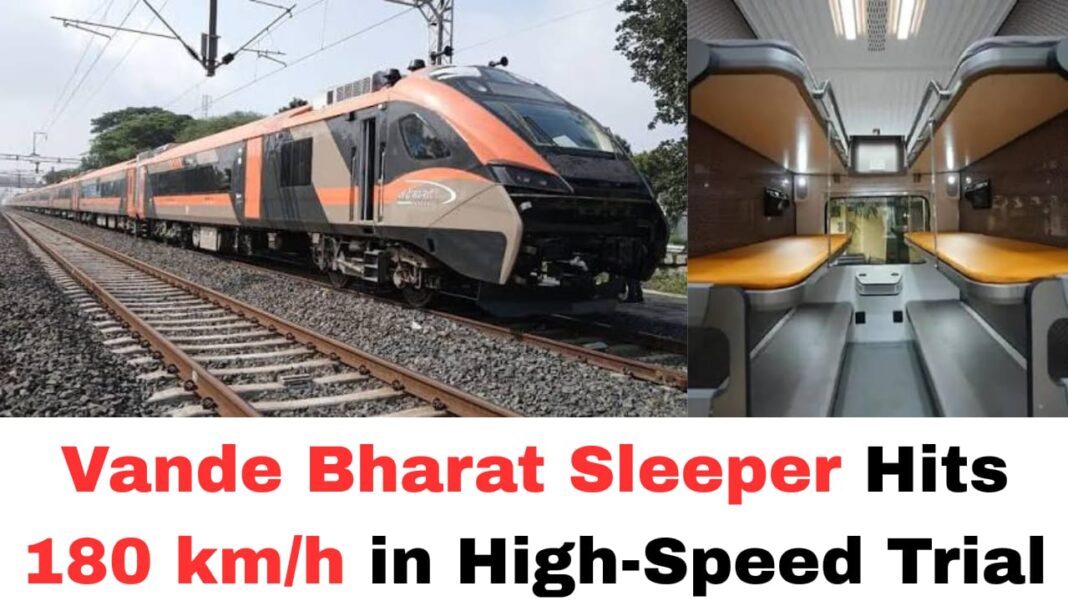Digital News Guru National Desk:
180 km/h Achieved: Vande Bharat Sleeper Trial Marks Big Leap in Indian Rail Speed
India’s rail-modernisation drive has just achieved a significant milestone: the new sleeper version of the Vande Bharat train, developed by BEML Limited for Indian Railways, successfully reached a top speed of 180 km/h during a high-speed test run in the Kota division of the West Central Railway.
The trial began on 2 November 2025 and is scheduled to run until 17 November, under the supervision of the Research Designs & Standards Organisation (RDSO), Lucknow. The section used was the Sawai Madhopur–Kota–Nagda stretch.

What was tested
Key details from the trial:
- A 16-coach sleeper rake was used, fully loaded with simulated passenger-weight conditions (including an additional 108 tonnes of iron-dust-filled canisters) bringing the total load to roughly ~800 tonnes.
- The long confirmatory run spanned about 50 km at 180 km/h between Rohalkhurd and Laban stations.
- Other tests included oscillation/stability under load, emergency braking on wet tracks, and full load mechanical/electrical system checks.
Why this matters
This trial is important on several fronts:
- Speed benchmark – Achieving 180 km/h signals that Indian-manufactured long-distance sleeper trainsets are capable of operating at speeds traditionally reserved for shorter premium day-services. It raises the bar for overnight/long-haul rail travel in India.
- Modernised comfort & safety – The sleeper train is designed with high-end features: crash-worthy structures, advanced bogies for stability, fire-safety to European norms (EN45545 HL3), individual USB ports and reading lights, quieter interiors, digital control systems, etc.
- Strategic alignment – This effort ties in with government programmes like Mission Gati Shakti and Mission Raftar, which aim to upgrade speeds, capacity and logistics efficiency on railways.
- Enhancing long-haul service – So far, the existing Vande Bharat services have been largely shorter-distance, chair-car type trains. This sleeper version is targeted at long overnight routes (e.g., Delhi–Mumbai, Howrah–Chennai etc), potentially replacing older premium trains with faster, more comfortable options.

What remains ahead
While the 180 km/h figure is impressive, several caveats and next-steps are crucial:
- Operational speed vs trial speed: A trial speed of 180 km/h doesn’t automatically translate to commercial services at that speed. Track conditions, signalling, braking distances, safety systems and maintenance regimes will limit operational speeds. For instance, some reports indicate that the commercial design speed will be 180 km/h but regular operation likely at around 160 km/h.
- Certification and safety clearance: The train must undergo final evaluation by the Railway Safety Commissioner before induction into service. Trials will continue with varied loads and conditions.
- Route selection & infrastructure readiness: Only sections of track upgraded to handle such speeds will see the train. Infrastructure work—tracks, electrification, signalling, curves, gentle gradients—must support high-speed safe operations.
- Deployment timeline: Although the trial has succeeded, full service rollout will take time: manufacturing of rakes, training of crews, route planning, ticketing and integration into network scheduling. According to some sources, production of 10 sleeper trains is underway, and a long-term plan targets about 200 such rakes.
The passenger promise
For travellers, what could this mean?
- Faster overnight travel: Suppose a route that presently takes 14–16 hours might shrink by 1–2 hours or more, depending on stops and corridors.
- Premium amenities: First class AC coaches with hot-water showers, business-class style layouts, noise-reduction, USB ports, digital info systems.
- Upgraded safety & comfort: Improved ride smoothness (a glass of water in a trial remained steady even at 180 km/h).

Challenges & considerations
But there are also key challenges ahead:
- Cost of upgrades: High-speed capable infrastructure is expensive. Only selective corridors may be suitable for full advantage.
- Ticket pricing and demand: Premium features may lead to higher fares; access and affordability will be factors.
- Network integration: High-speed trains must fit into a network with slower services, mixed traffic, freight and conventional trains; scheduling and prioritisation become complex.
- Maintenance and reliability: High-speed operations demand higher standards of maintenance, reliability of systems and safety oversight.
Conclusion
The successful 180 km/h trial of the Vande Bharat Sleeper signals a bold step forward for India’s rail ambitions. It brings together domestic manufacturing (BEML/Indian Railways), modern design, increased speeds and premium passenger experience. While the road from trial to full commercial service has many milestones—certification, infrastructure readiness, manufacturing scale-up—the momentum is clear. For travellers on India’s long-haul overnight routes, the future promises a faster, smoother, smarter journey.
You May Also Read: Delhi Airport ATC Glitch Delays Over 800 Flights








